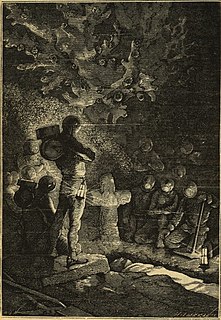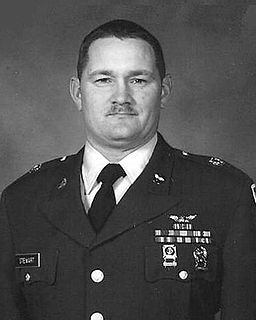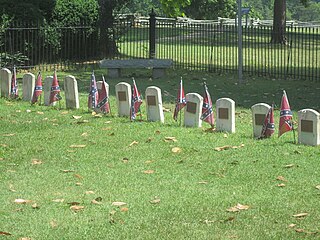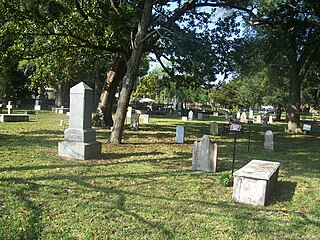
A cemetery, burial ground or graveyard is a place where the remains of dead people are buried or otherwise interred. The word cemetery implies that the land is specifically designated as a burial ground and originally applied to the Roman catacombs. The term graveyard is often used interchangeably with cemetery, but a graveyard primarily refers to a burial ground within a churchyard.

Arlington National Cemetery is a United States military cemetery in Arlington County, Virginia, across the Potomac River from Washington, D.C., in whose 639 acres (259 ha) the dead of the nation's conflicts have been buried, beginning with the Civil War, as well as reinterred dead from earlier wars. The United States Department of the Army, a component of the United States Department of Defense (DoD), controls the cemetery.

Burial or interment is a method of final disposition wherein a dead person or non-human animal is placed into the ground, sometimes with objects. This is usually accomplished by excavating a pit or trench, placing the deceased and objects in it, and covering it over. A funeral is a ceremony that accompanies the final disposition. Humans have been burying their dead since shortly after the origin of the species. Burial is often seen as indicating respect for the dead. It has been used to prevent the odor of decay, to give family members closure and prevent them from witnessing the decomposition of their loved ones, and in many cultures it has been seen as a necessary step for the deceased to enter the afterlife or to give back to the cycle of life.
The Commonwealth War Graves Commission (CWGC) is an intergovernmental organisation of six independent member states whose principal function is to mark, record and maintain the graves and places of commemoration of Commonwealth of Nations military service members who died in the two World Wars. The commission is also responsible for commemorating Commonwealth civilians who died as a result of enemy action during World War II. The commission was founded by Sir Fabian Ware and constituted through Royal Charter in 1917 as the Imperial War Graves Commission. The change to the present name took place in 1960.

A grave is a location where a dead body is buried. Graves are usually located in special areas set aside for the purpose of burial, such as graveyards or cemeteries.

A headstone, tombstone, or gravestone is a stele or marker, usually stone, that is placed over a grave. It is traditional for burials in the Christian, Jewish, and Muslim religions, among others. In most cases, it has the deceased's name, date of birth, and date of death inscribed on it, along with a personal message, or prayer, but may contain pieces of funerary art, especially details in stone relief. In many parts of Europe, insetting a photograph of the deceased in a frame is very common.

Salisbury National Cemetery is a United States National Cemetery located in the city of Salisbury, in Rowan County, North Carolina. It was established at the site of burials of Union soldiers who died during the American Civil War while held at a Confederate prisoner of war camp at the site.

Knoxville National Cemetery is a United States National Cemetery located in the city of Knoxville, Tennessee, United States. Established during the Civil War in 1863, the cemetery currently encompasses 9.8 acres (4.0 ha), and as of the end of 2007, had 9,006 interments. The 60-foot (18 m) Union Soldier monument, which stands in the eastern corner of the cemetery, is one of the largest Union monuments in the South. In 1996, the cemetery was added to the National Register of Historic Places as part of a multiple properties submission for national cemeteries.

Patrick Dana Stewart was a soldier in the United States Army. He died in combat in Afghanistan when his Chinook helicopter was shot down by a rocket-propelled grenade while returning to base. Patrick Stewart was a resident of Fernley, Nevada, United States and a practising Wiccan.

The United States Department of Veterans Affairs (VA) maintains many cemeteries specifically devoted to veterans. Most have various rules regarding what must take place in order to be interred there.

Luxembourg American Cemetery and Memorial is a Second World War American military war grave cemetery, located in Hamm, Luxembourg City, Luxembourg. The cemetery, containing 5,073 American war dead, covers 50.5 acres (20.4 ha) and was dedicated in 1960. It is administered by the American Battle Monuments Commission.

Gilead Cemetery is located in the town of Carmel, New York, United States. It is off a bend in Mechanic Street 1.5 miles (2.4 km) south of the hamlet of Carmel, seat of Putnam County.

The Appomattox Court House National Historical Park cemeteries are part of the Appomattox Court House National Historical Park, which was listed on the National Register of Historic Places on June 26, 1989.
The Funeral Rule, enacted by the Federal Trade Commission on April 30, 1984 and amended it effective 1994, was designed to protect consumers by requiring that they receive adequate information concerning the goods and services they may purchase from a funeral provider.

The Arlington National Cemetery mismanagement controversy is an ongoing investigation by the United States Department of Defense into mismanagement, poor record-keeping, and other issues involving the burial and identification of U.S. servicemembers' graves at Arlington National Cemetery in Arlington, Virginia. Questions were raised in 2008, and the scandal peaked in the spring of 2010.

The Huguenot Cemetery in St. Augustine, Florida located across from the historic City Gate was a Protestant burial ground between the years 1821 and 1884. The Spanish colonial city of St. Augustine, along with the entire Florida Territory became de facto American possessions after the 1819 signing of the Adams-Onis Treaty. The actual physical occupation of the city and Florida territory occurred in 1821.

The Victims of Terrorist Attack on the Pentagon Memorial is a memorial over a group burial site at Arlington National Cemetery in the United States. It commemorates the victims of the Pentagon, which was struck by al-Qaeda terrorists as part of the September 11 attacks. The memorial specifically honors the five individuals for whom no identifiable remains were found. However, a portion of the remains of 25 other victims are buried at the site. The names of the 115 Pentagon employees and 10 contractors in the building, as well as the 53 passengers and six crew members aboard American Airlines Flight 77 are inscribed on the memorial.

Ute Cemetery, known as Evergreen Cemetery in the 19th century, is located on Ute Avenue in Aspen, Colorado, United States. It is a small, overgrown parcel with approximately 200 burials. In 2002 it was listed on the National Register of Historic Places.

Miramar National Cemetery is a federal military cemetery in the city of San Diego, California. It is located in the north west corner of the Marine Corps Air Station Miramar on the grounds of old Camp Kearney (1917) and Camp Elliott (1942).

Atherton War Cemetery is a heritage-listed cemetery at the corner of Kennedy Highway and Rockley Road, Atherton, Tablelands Region, Queensland, Australia. It was built in 1942. It was added to the Queensland Heritage Register on 19 November 2010.



















